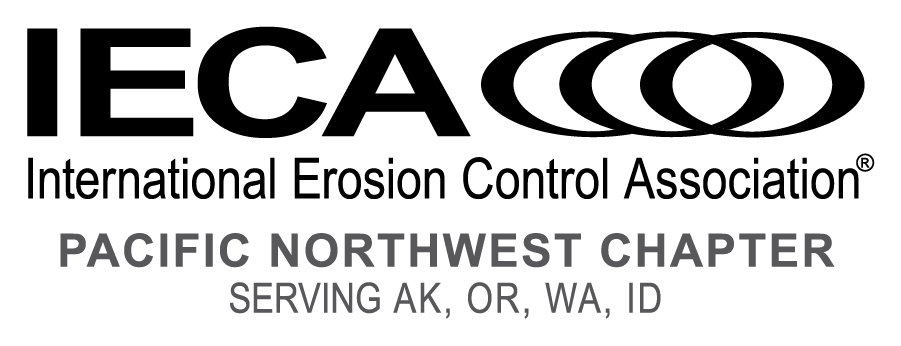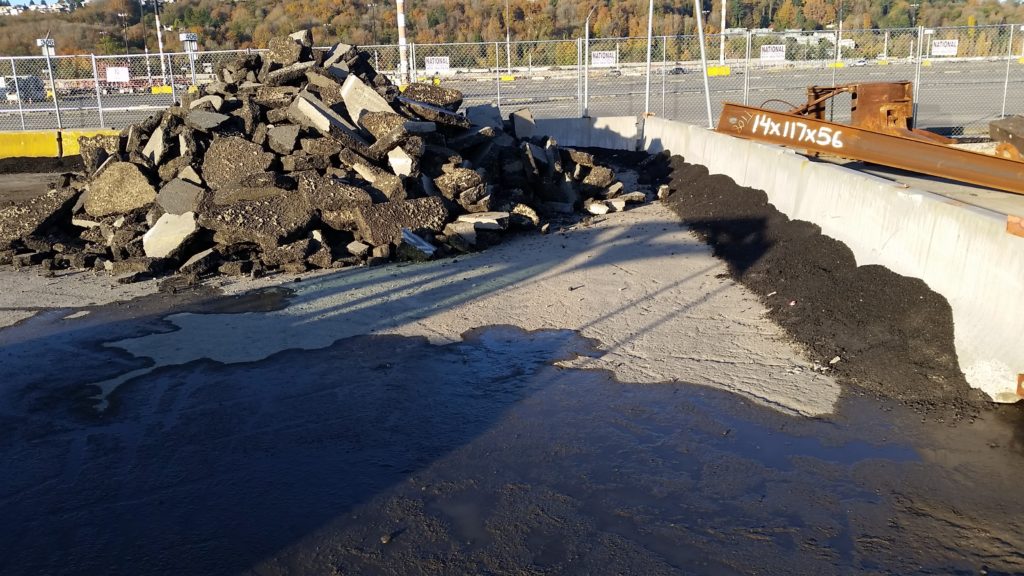January 8, 2021
Soil Stockpile BMPs
August 18, 2020
Silt Fence, Covered Stockpile
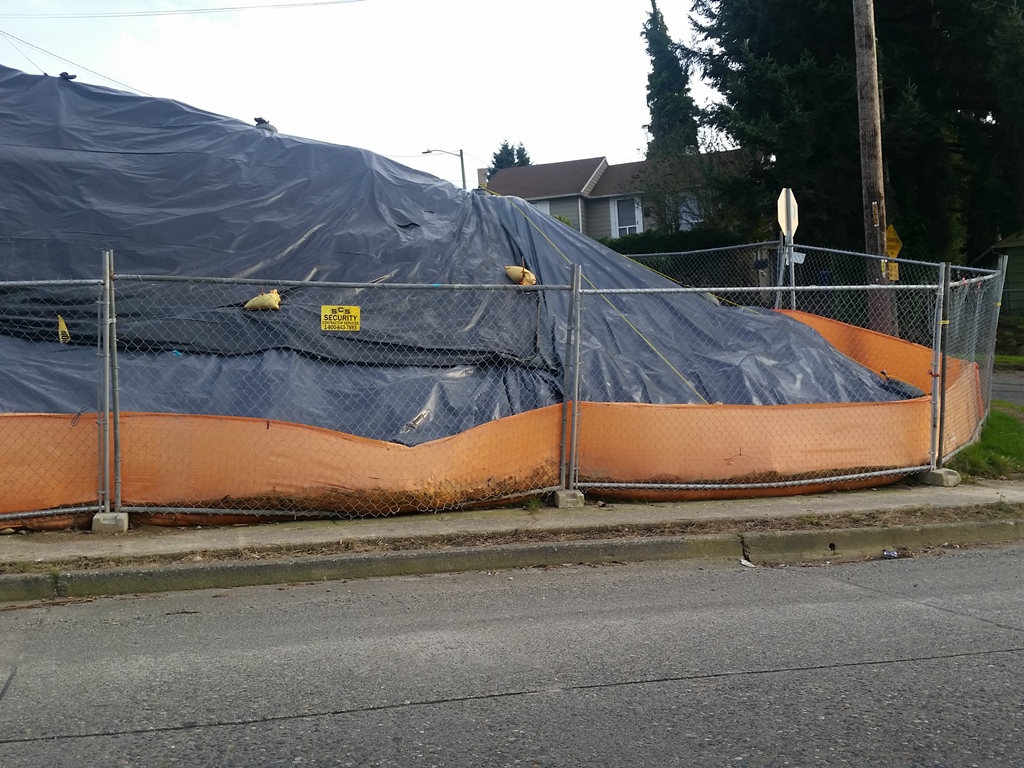
I saw this driving by a new apartment building project. Everything is so tidy. They attached the silt fence to the cyclone fence and secured the black plastic stockpile cover from damaging wind.
July 1, 2020
June 11, 2020
Phasing a Stockpile Project to Prevent Dirty Runoff From Draining to Wetlands
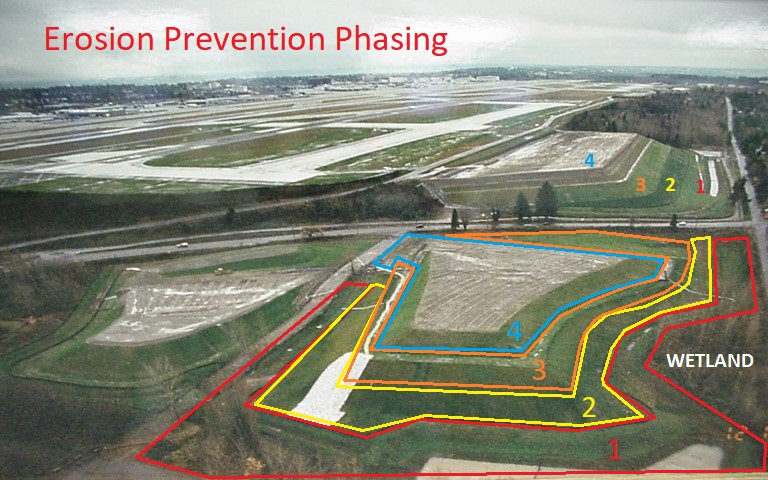
Phasing a Stockpile Project
Phase 1-
(A) Install silt fences on perimeter and at base of future stockpile.
(B) Clear, grub, grade, construct drainage ditches and temporary stormwater pond including outlet structure and perforated pipe level spreader drains. Grade to drain water away from outer perimeter silt fence and toward ditch.
(C) Hydroseed and install blankets in ditch line.
(D) NOTE: Background stockpile, built later, used an early generation construction stormwater treatment system and discharged to creek instead of level spreaders into vegetation.
Phase 2-
(A) Place and compact fill material to approximately 20 feet of vertical elevation.
(B) Trackwalk and hydroseed slope.
Phase 3-
(A) Same as Phase 2.
(B) Same as Phase 2.
Phase 4-
(A) Place and compact fill material to approximately 20 feet of vertical elevation. Start base of slope 15 feet in from lower fill and grade to drain away from lower slope and to the stormwater pond.
(B) Trackwalk and hydroseed slope.
(C) No hydroseed on top of the pile as material is continually brought in as available.
April 3, 2020
Eroded Stockpile

This eroded stockpile is well within the project boundaries and there is nothing leaving the project. I consider this a problem for the contractor, not for water quality compliance. By allowing this to occur, the contractor has made the eroded stockpile soil unsuitable for use in embankment fill and has to haul it offsite at their expense. This could have been avoided by berming the top of the stockpile to direct water to pipe slope drain pipe that prevents water from flowing over the side of the fill.
September 20, 2019
Excellent Stockpile
I saw this excellent stockpile on a waterfront construction project and had to shoot a video.
July 25, 2019
Uncovered Stockpile after a Rain Storm
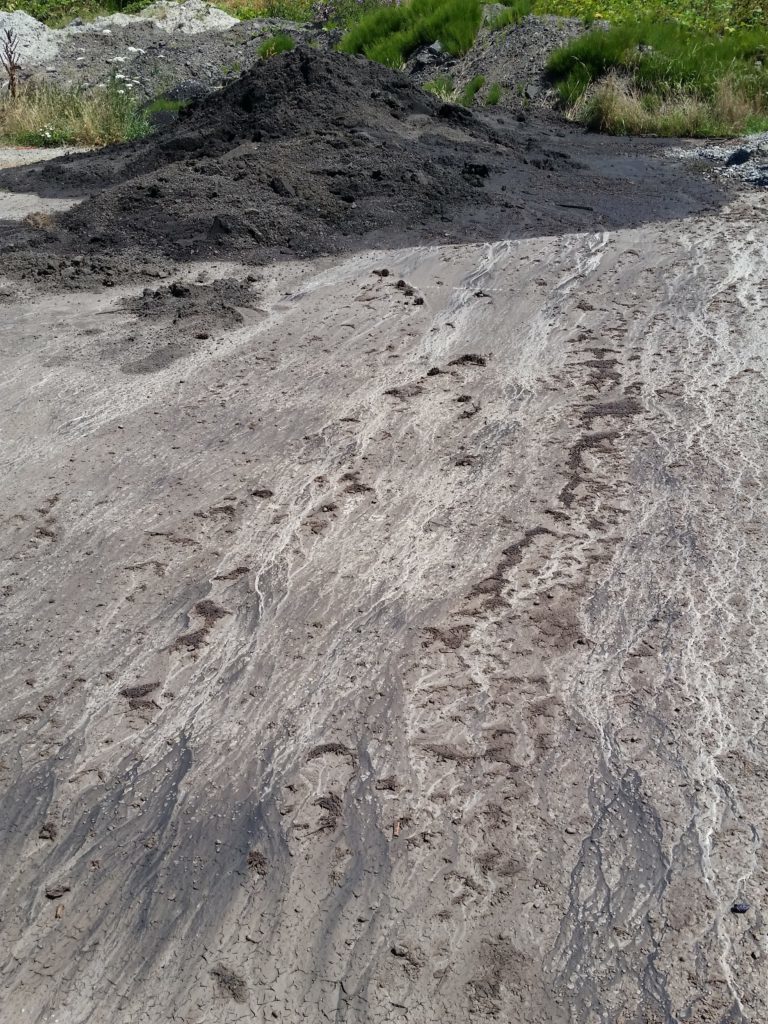
It’s just and uncovered stockpile after a rain storm. The stockpile happens to be ground asphalt from a road project.
September 17, 2018
Soil Stockpile on Plastic
Soil Stockpile Needs to be on Plastic – Soil stockpiled on asphalt will leave soil residue no matter how much you sweep. When possible, we stockpile soil on heavy plastic, plywood, geotextile fabric, or some other material.
February 6, 2015
Inspecting Soil Stockpiles
Inspecting Soil stockpiles: they need to be covered when not being used. This helps both with keeping the soil dry in the case of reusing it for backfill and with preventing rain from washing soil into the storm drainage system.
In addition, fugitive dust is prevented from blowing off of the stockpile in windy areas. If the stockpile is to remain in place for longer than a few weeks, black plastic, (at least 6 mil thickness) should be used, as the black plastic is UV (ultraviolet light) stabilized and won’t break down as quickly in sunlight as will clear plastic, which is not UV stabilized.
The plastic needs to completely cover the soil. If soil is exposed at the base of the pile, clean rainwater will run off of the plastic and into the exposed soil causing erosion of the soil and will generate dirty water runoff that can flow into the storm drainage system. In order to keep the plastic in place and prevent it from blowing off in the wind, plenty of sandbags or some other heavy material needs to be used to hold it in place.
As with the plastic itself, sandbag fabric should be UV stabilized if they will be in place for longer than about a month. White sandbags will deteriorate fairly quickly in strong sunlight.
June 1, 2021
Dust Control-Let’s Clear the Air
PNW Virtual Connection: Dust Control-Let’s Clear the Air
Already registered? Log in now.

Hosted by the International Erosion Control Association, the Idaho State Representative and the Pacific Northwest Chapter of IECA
Join the International Erosion Control Association (IECA) for The Pacific Northwest Virtual Connection: Dust Control – Let’s Clear the Air. This event offers two (2) recorded webinars with 2 hours of available Professional Development Hours. No cost for IECA members and $25 USD for nonmembers. Learn from industry leaders as they tackle the tough challenges of soil stabilization and dust control.
Attendees can expect to learn about natural soil stabilizers for the control of dust on roads, mines, and stockpiles as well as controlling dust during typical construction activities such as earthmoving, hauling, cutting, drilling, and asphalt preparation.
Agenda:
On-Demand
Dust Palliatives and ApplicationsMatt Smith, HMI Hamilton Manufacturing, Inc.
Maintaining air quality during construction is difficult. Environments and soil types vary as much as dust palliative products. This presentation will address application practices and product variations to find the right product for your project. Controlling Fugitive DustDerek Aubrey, Spokane Regional Clean Air Agency
Why is fugitive dust an issue and what reasonable precautions can you take to prevent it. What things will a compliance inspector be looking for while observing your site.
On-Demand
Managing Fugitive Dust from Construction Projects
Dave Jenkins, CPESC, President IECA-PNW Chapter
Fugitive dust from construction activities is a nuisance to neighbors, a hazard to workers and may violate local and state air quality regulations. This presentation, based on the 1997 AGC of Washington and Fugitive Dust Task Force brochure “Guide to Handling Fugitive Dust from Construction Projects”, will cover construction dust sources and how to manage them, including earthmoving, loading, unloading, stockpiling, haul roads, concrete cutting and drilling, sediment track out and other construction “means and methods”.
Notice: After you register for this event, be sure to ‘add to calendar’ either from the content tab or when you receive the confirmation email. You will join the event through this same page in the IECA eHub. If you miss a live event, it will be recorded.
Hosted by:
